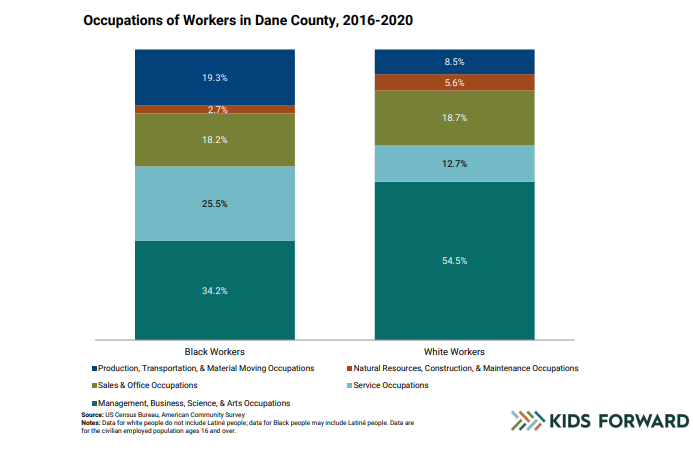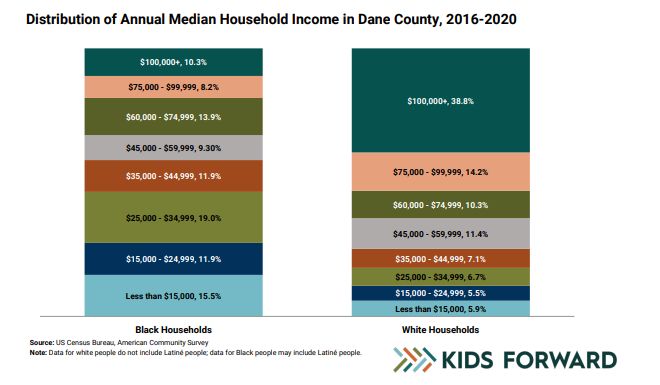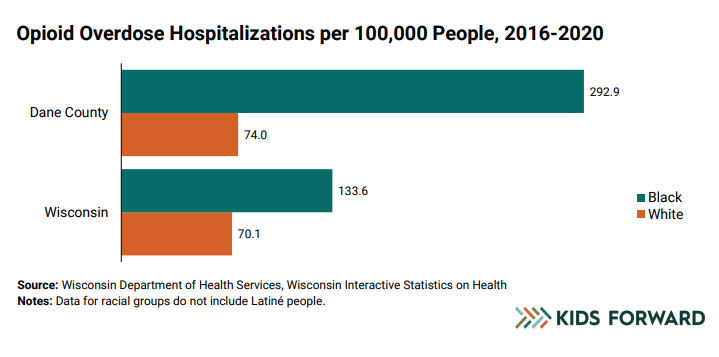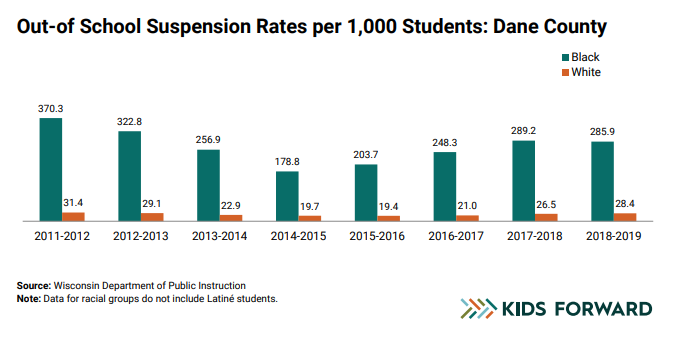While some measures of prosperity have improved for Black residents of Dane County in the past 10 years, disparities between Black and white income, wealth, educational attainment and health care outcomes have, for the most part, not.
That’s one of the key takeaways of the Race to Equity 10-year report issued by Kids Forward today.
The report comes a decade after the Race to Equity baseline report surprised many white residents and leaders in the Greater Madison area by demonstrating that racial disparities in Dane County – considered a liberal haven of equality and tolerance – were worse than anywhere else in the country.
The new report issued today indicates that by most measures, those disparities have not improved.
One of the report’s main authors cautioned against comparing the two reports directly.
“It is a new report, it has a totally different intention, different writers and entirely different team, and ultimately a much different goal,” said Carte’cia Lawrence, senior racial equity policy analyst at Kids Forward, the organization that issued the report. “Unfortunately, you won’t be able to grab data from the 2013 report and compare it directly to the 10-year report … but this report does begin to unpack how race and gender class and in otherwise impacts Dane County residents.”
One of the key differences in the 10-year Report is the addition of qualitative data, including information on lived experience that can’t always be represented as data, Lawrence said. That qualitative data was collected through focus groups and interviews, with many quotes and anecdotes included in the report.
“To truly grasp the impact of racial disparities, you have to get out into the community and talk to residents,” Lawrence said.
In addition to those focus groups and interviews, the bulk of the report is a gathering and synthesis of statistics from a variety of sources, such as the United States Census Bureau and several Dane County and State of Wisconsin agencies.
The 10-Year Report focuses on three areas: economic well-being, health and education.
“Focusing on root causes is a great way to understand why racial disparities are profound and persistent,” Lawrence said of the decision to focus on those three areas. Further, those three areas are intertwined.
“Your economic well-being affects your health, your health affects your education, all of these things,” she said. “We have to approach these issues holistically to truly make an impact.”
Listen to our interview with Carte’cia Lawrence:
Economic well-being
“The main finding of the report is that there’s a lack of shared prosperity amongst Black residents in Dane County,” Lawrence said.
For example, median income for white households in Dane County is $80,063; for Black households, it’s less than half that – $37,415.
Median household income has improved for Black households in the last 10 years, but not as much as it has for white households.
“When things get better for white residents, they get better for Black residents last and to a much lesser extent,” Lawrence said. “Black residents are earning less, they’re more likely to work in low-wage positions. They’re four times less likely to own homes despite income levels.”


Health
Black residents are less likely to have health insurance, more likely to give birth early and more likely to lose a child in the first year of life.
They’re also 3.1 times more likely to be hospitalized for an opioid overdose, 5.6 times more likely to be hospitalized for heart failure, 8.1 times more likely to be hospitalized for diabetes, 11 times more likely to be hospitalized for hypertension.
“Despite the fact that Wisconsin is doing a pretty good job of covering its residents (with health insurance), the health outcomes for Black residents are still far worse,” Lawrence said.


Education
In Dane County, 58.7 percent of white fourth graders exhibit proficiency in language arts; only 12.5 percent of Black students do.
Similarly, 46.9 percent of white students exhibit proficency in math in eighth grade; only 6.4 percent of Black students do.
Beyond academics, the day to day school experience has its disparities as well. Black students are twice as likely to have an individualized education plan and 10 times as likely to be suspended.
“We know that discipline data, such as our school suspension rates, isn’t a reflection of what’s actually going on in schools,” Lawrence said. “It doesn’t necessarily mean that black students and other students are having issues in school to the point where they might be suspended. But we know that discipline data is a reflection of the decisions of school administrators.”

What do we do about it?
Each section of the report contains a number of recommendations for both policymakers and the private sector. Addressing the many disparities in multiple areas of life won’t come down to anyone, or even a few, strategies, Lawrence said.
“There needs to be a concerted effort to improve the lives of Black residents in Dane County and beyond,” Lawrence said. “Addressing one thing won’t allow us to truly make an impact. We have to approach these issues holistically … We believe that if there’s not an intentional focus by decision-makers, employers, et cetera, to address the anti-Blackness and racism that continues to persist within Dane County, then 10 years from now we’ll see this exact same data, and it might be even worse.”
Lawrence said many disparities could be addressed by paying all workers a living wage, guaranteeing paid family and medical leave, paying teachers more and making child care more affordable.
“That doesn’t necessarily have to happen legislatively,” Lawrence said. “Employers can agree to pay their workers a living wage. You don’t have to be mandated to pay folks a wage that they can afford to live on in Dane County.
She also said more funding for grassroots, Black-led organizations would help – and that doesn’t have to come from the government.
“It’s going to take all of us,” she said. “It’s going to take the private sector, it’s going to take philanthropy, it’s going to take a government. Everybody needs to commit to addressing anti-Blackness and racism that still permeates Dane County and beyond. If not, we are going to see these numbers look the exact same and potentially worse and 10 years. The race-neutral policies that don’t necessarily address how black folks are constantly at the lower rung … won’t work.”
While much of the data included in this report comes from the period leading up to the COVID-19 pandemic and doesn’t include the disproportionate effects of the disease and its impacts on Black residents, Lawrence said pandemic-era policy decisions showed how it’s possible to address these issues, when the will is there.
“We did some work on this last year, talking through the impact of COVID relief on poverty. We saw, through the supplemental poverty measures that when we saw increases in benefits, such as food stamps and the stimulus checks that, for the first time, we actually saw major decreases in poverty,” Lawrence said. “And what that tells me is that we know exactly how to address poverty. Some people just don’t want to do that.”
Lawrence said Kids Forward will continue to address disparities, but also empower others to do so as well.
“Our priority right now is really to get this (report) in the hands of Black-led organizations and Black leaders to be able to equip them with tools to advocate for themselves … but also thinking of ways to partner with different BIPOC organizations in Dane County and statewide, figure out exactly how we’re going to continue to advocate for these issues.”
Read the full report at https://kidsforward.org/race-to-equity/.




























